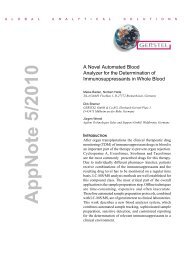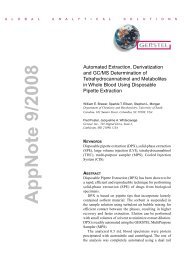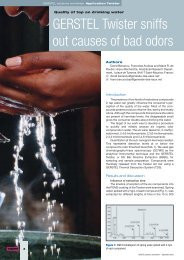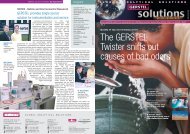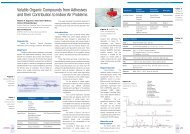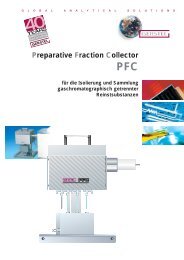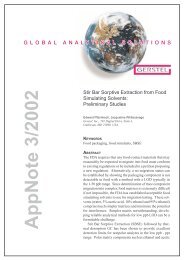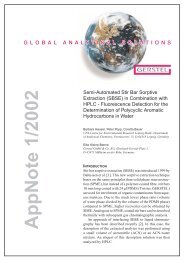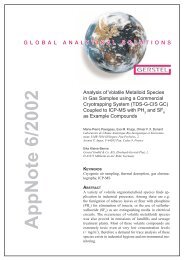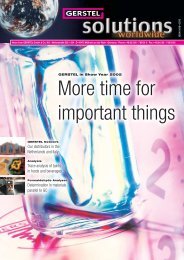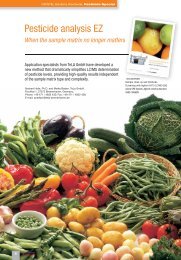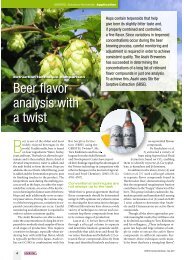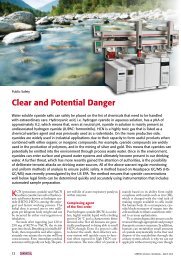GERSTEL Solutions No. 7 (pdf; 1,86 MB)
GERSTEL Solutions No. 7 (pdf; 1,86 MB)
GERSTEL Solutions No. 7 (pdf; 1,86 MB)
Create successful ePaper yourself
Turn your PDF publications into a flip-book with our unique Google optimized e-Paper software.
<strong>GERSTEL</strong> <strong>Solutions</strong> Worldwide Application<br />
To expose forgeries, the Document Laboratory<br />
of the Zurich Cantonal Police successfully<br />
applies thermal desorption coupled with<br />
GC/MS.<br />
Rolf Hofer, Ph.D.<br />
Forensic Science Division<br />
Head of Document Laboratory<br />
Zurich Cantonal Police<br />
holf@kapo.zh.ch<br />
Andreas Rippert, Ph.D.<br />
Forensic Science Division<br />
Zurich Cantonal Police<br />
ripp@kapo.zh.ch<br />
A new method helps to clearly establish the facts and determine whether<br />
handwritten or printed text is authentic or not. If not, it can be determined at<br />
what point in time the text was altered.<br />
Hot in pursuit of forgers<br />
Forensic science has contributed greatly<br />
to the exposure of forgeries: „Today<br />
we are in a position to determine<br />
if handwritten or printed lines are original<br />
or if they have been manipulated, if documents<br />
have been altered or if they have been<br />
forged entirely”, says Dr. Andreas Rippert<br />
of the Department of Forensic Sciences of<br />
the Zurich Cantonal Police. The forensic<br />
chemist adds: „We can now also pinpoint<br />
the time when a document was forged,<br />
which could help us solve open cases.”<br />
The document laboratory of<br />
the Zurich Cantonal Police<br />
uses a <strong>GERSTEL</strong> Thermal<br />
Desorption System (TDS) in<br />
combination with a <strong>GERSTEL</strong><br />
Cooled Injection System (CIS)<br />
and an Agilent Technologies<br />
GC 6890 / 5973 MSD. The<br />
system is used to differentiate<br />
between ink samples.<br />
Pyrolysis GC/MS<br />
complicates the picture<br />
Pyrolysis GC/MS is often used to examine<br />
paper and documents. The sample is pyrolyzed<br />
under anaerobic conditions, i.e. under<br />
a flow of oxygen-free inert gas. While<br />
Pyrolysis GC/MS provides a lot of information,<br />
the technique does pose a problem, according<br />
to Dr. Rippert: „Attempts to reveal<br />
the document’s material composition using<br />
pyrolysis GC/MS result in a large number<br />
of peaks, which could originate either from<br />
the ink or from the paper. In addition, the<br />
high temperatures used give rise to decomposition<br />
products that further complicate<br />
data interpretation.”<br />
Thermal Desorption – the<br />
method of choice<br />
„To reach a clear conclusion about the authenticity<br />
of a document, a GC introduction<br />
method is needed that provides the<br />
possibility of varying, i.e. programming the<br />
temperature over the course of the thermal<br />
desorption / thermal extraction step. Organic<br />
compounds are extracted from the<br />
sample in successive steps at different temperatures”,<br />
says Dr. Rolf Hofer of the Department<br />
of Forensic Sciences of the Zurich<br />
Cantonal Police. Dr. Hofer and his forensic<br />
expert colleagues used the <strong>GERSTEL</strong> Thermal<br />
Desorption System (TDS) to develop<br />
22<br />
<strong>GERSTEL</strong> <strong>Solutions</strong> Worldwide – May 2007



